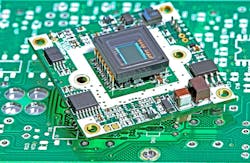Compliance testing for the Sensor Open System Architecture (SOSA) technical standard to start next year
WASHINGTON – It's one thing to lay out an open-systems industry standard, but it's quite another to enforce compliance to the standard.
That's exactly what embedded computing experts working with The Open Group in San Francisco are wrestling with when it comes to the Sensor Open System Architecture (SOSA) technical standard, which is intended to reduce development and integration costs for military capabilities and reduce time to field.
The SOSA 1.0 standard was unveiled one year ago, yet ways to enforce conformance and certify compliance are still in progress, says Ilya Lipkin, who chairs the SOSA steering committee for the Open Group, and is an open-architecture technical experts for the U.S. Air Force Research Laboratory at Wright-Patterson Air Force Base, Ohio.
SOSA compliance testing will ensure that embedded computing components conform to the standard could start as early as next year. Lipkin made his comments last month at the Association of Old Crows electronic warfare conference and trade show in Washington.
SOSA seeks to streamline U.S. military capabilities by enabling rapid, affordable, cross-platform capabilities based on best practices of system, software, hardware, and electrical and mechanical engineering.
The standard encapsulates fundamentals of the Modular Open Systems Approach (MOSA) design approach to develop embedded computing solutions for military applications that involve a unified set of sensor capabilities.
SOSA experts are working to create the SOSA Conformance Test Tool Framework (CTTF), which could be ready within the next three years, Lipkin says. The CTTF could help speed SOSA conformance testing by automating the process.
Related: The official Sensor Open Systems Architecture (SOSA) standard is out; so now what?
"We're doing everything we can to make it cheap, fast, and autonomous," Lipkin says. "They want certification to take only weeks, not months."
Until an embedded computing vendor earns SOSA verification and certification, that vendor can claim only alignment to the SOSA standard, not compliance.
Conformance testing will consist of SOSA verification and certification; verification is to demonstrate that the vendor meets the what he says he's going to do, and should be the most complex and time-consuming part of the process.
Related: SOSA standard taking hold in military embedded computing
The CTTF should help reduce the costs of SOSA compliance, speed the process, and make it less complex, Lipkin says. Conformance testing will be at the circuit card level, and not at the chassis or system level.
Until the CTTF is ready, SOSA compliance testing will be more of a manual process. Open Group officials are trying to start the first conformance tests by February 2023. The costs and duration of the first compliance tests are yet to be determined.
The first snapshot of SOSA 2.0, meanwhile, should be available for industry review by August 2023. For more information contact the Open Group's SOSA Consortium online at www.opengroup.org/sosa.
About the Author
John Keller
Editor-in-Chief
John Keller is the Editor-in-Chief, Military & Aerospace Electronics Magazine--provides extensive coverage and analysis of enabling electronics and optoelectronic technologies in military, space and commercial aviation applications. John has been a member of the Military & Aerospace Electronics staff since 1989 and chief editor since 1995.
